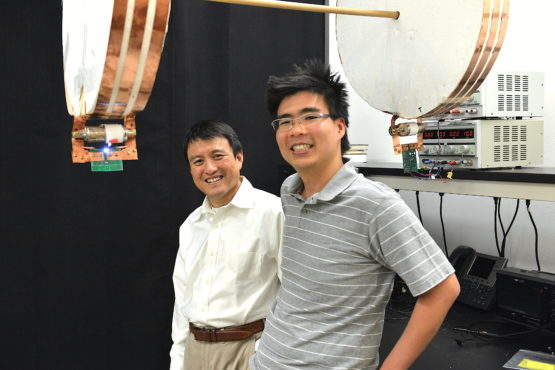

A research team at Stanford University has hit a breakthrough in its work on developing wireless power transfer. The project is focused on the transfer of power for moving objects, building on previous work undertaken at Massachusetts Institute of Technology into transmitting power over a few feet for stationary objects.
In June, the researchers, led by professor of electrical engineering Shanhui Fan, published a study entitled Robust wireless power transfer using a nonlinear parity-time-symmetric circuit, explaining how they have effectively managed to transfer small amounts of power between moving objects. This is a significant breakthrough for the technology, bringing it closer to real-life application.
Getting the power project moving
One such real-world application that holds great promise and transformative potential is the powering of electric vehicles. The problem that has plagued electric vehicles (EV) since their inception is their limited driving range. Distance has increased as battery technology has improved over the years, but even leading Tesla EVs are limited to 315 miles. This reduces the desirability of EVs, particularly as the time they take to recharge is much higher than refuelling their diesel or petrol-fuelled counterparts.
“The problem is widely recognised in the wireless power transfer community and people have been looking for ways round this problem,” says the study’s lead author Sid Assawaworrarit. This has led numerous groups to suggest wireless power as a possible solution.
How well do you really know your competitors?
Access the most comprehensive Company Profiles on the market, powered by GlobalData. Save hours of research. Gain competitive edge.

Thank you!
Your download email will arrive shortly
Not ready to buy yet? Download a free sample
We are confident about the unique quality of our Company Profiles. However, we want you to make the most beneficial decision for your business, so we offer a free sample that you can download by submitting the below form
By GlobalData“A couple of research groups have worked on building a feedback control on top of a conventional set-up to regulate the transferred power and optimise for efficiency at the cost of increasing the system complexity,” continues Assawaworrarit.
Wireless charging would allow the vehicles to power up as they drive using a rotating copper coil in the base of the vehicle and other coils within specially constructed roads. For this sort of system, power would only need to travel relatively short distances of around a metre.
“Our group has been working on various aspects of wireless power transfer for a few years,” says Assawaworrarit. “Earlier work by Xiaofang Yu, also an author, in 2013 has highlighted sensitivity issues inherent in many wireless power transfer systems where the transfer efficiency and the amount of power transferred change drastically as a result of changes in the transfer distance or the surrounding environment.”
Wireless power transfer: how does it work?
Wireless power transfer is based on magnetic resonance coupling. When coils of wire rotate between magnets, electricity moves through these copper wires, creating an oscillating magnetic field. This field can also cause electrons in nearby wires that are tuned to the same frequency to oscillate, thus transferring power without connecting wires.
Problems arise when the object containing the receiver coil does not remain stationary. As Assawaworrarit explains: “In a conventional scheme where one typically generates the source’s radio waves at a pre-determined frequency, a problem arises when selecting the optimal frequency, which depends, sometimes sensitively, on the transfer distance and relative orientation of the source and receiver. With frequency fixed, if the distance fluctuates away from its designed value, the transfer efficiency drops, thus limiting the wireless power transfer to stationary charging.”
The frequency must remain the same, despite the wires moving, for there to be a continuous power flow. This has previously caused problems, as the wires have had to be constantly manually retuned to achieve successful power transfer. It was this that Assawaworrarit and the team set out to fix.
“The paper’s main breakthrough is the realisation that the parity-time symmetry concept which can be used to create a robust wireless power transfer, where the transfer efficiency remains high as the distance between the coils varies, without the need of any active tuning,” says Assawaworrarit.
The system underwent some important changes to enable this breakthrough and make wireless power transfer appropriate for moving objects, such as EVs. “Instead of sending waves at a specific frequency, our design has a gain element incorporated into the transmitter,” Assawaworrarit says. “This set-up is said to be parity-time symmetric i.e. gain on one side, loss on the other, with the benefit that it automatically chooses the frequency that maximises the transfer efficiency and is able to maintain a constant power transfer level over a range of distance.”
The team tested this using an LED bulb attached to the receiving coil. In similar previous tests, the light the bulb gives off would have diminished as it moved further from the transmitter coil. But following the inclusion of an amplifier the power levels and the brightness of the bulb remained steady up to 3ft away.
A potential beyond EVs
Beyond cars, the technology could also be used to power personal devices such as mobile phones as users move about. It could also be implemented for robotics in manufacturing, freeing machines to work over far greater distances. There is also the possibility that it could be used for charging medical devices on or inside bodies without the need for surgery.
“The finding – that dynamic wireless power transfer is possible without the need for on-the-fly tuning – is general and can be applied to applications where there is a need for dynamic charging, for example powering moving vehicles or moving consumer-electronics devices,” says Assawaworrarit.
The project still has a number of hurdles to overcome before wireless power can be implemented outside of a laboratory. If it’s going to be effective for EVs, the amount of power will need to be significantly increased. The power required to light the LED bulb used in the team’s test is just one milliwatt charge, whereas electric cars require tens of kilowatts.
“We are looking to improve the efficiency of the amplifier employed in the current work,” says Assawaworrarit. “At present, the amplifier used in the circuit, which we obtained commercially, is of low efficiency. We aim to solve the efficiency problem within a year.”







